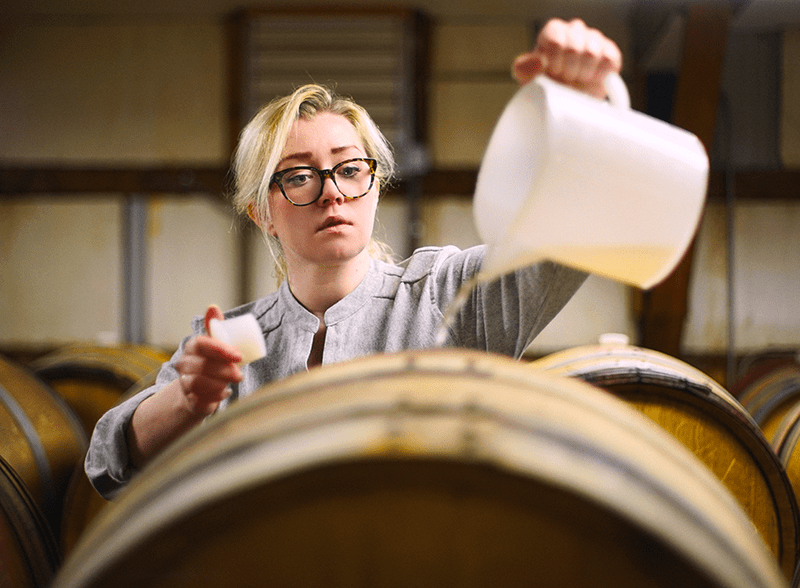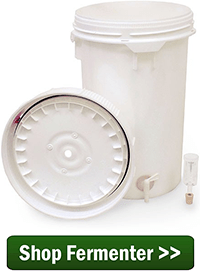 I have been following your blog for some time and find it very helpful. I have a question about blending wines. I am an amateur winemaker starting with grapes and moving on to fruit wines. I recently made about 3 gallons of semi-dry red raspberry wine from frozen raspberries that came out very nice but intensely full of flavor. My wife describes it as “almost wanting to pick the seeds out of your teeth”. Although it has a very nice finished wine I am thinking of blending a portion with other wines. I have a young peach that I will experiment with in a small batch but not sure about peaches and raspberry. What I am wondering is if you have any suggestions in blending this with a commercial wine such as a Riesling or a chardonnay.
I have been following your blog for some time and find it very helpful. I have a question about blending wines. I am an amateur winemaker starting with grapes and moving on to fruit wines. I recently made about 3 gallons of semi-dry red raspberry wine from frozen raspberries that came out very nice but intensely full of flavor. My wife describes it as “almost wanting to pick the seeds out of your teeth”. Although it has a very nice finished wine I am thinking of blending a portion with other wines. I have a young peach that I will experiment with in a small batch but not sure about peaches and raspberry. What I am wondering is if you have any suggestions in blending this with a commercial wine such as a Riesling or a chardonnay.
Name: Ray S.
State: Connecticut
—–
Hello Ray,
Blending homemade wines is a very subjective endeavor, but one that can improve a wine that is out of balance in some way. In a nutshell, you need to find a wine that is on the opposite end of the scale of the fault you are trying to fix, and then figure out how much of that wine you need to add to fix your wine’s fault. This is what blending wine at home is all about. It’s a technique for making 1 + 1 = 3.
In the case of your raspberry wine, it sounds like the flavor is too intense in some way. This usually means that the wine is too acidic. That would be my guess, but don’t let me tell you what is at issue. Think it through.
Citric acid is the primary acid in raspberries and would make the wine too sharp or tart tasting, particularly if the fruit used to make the wine happened to be too tart, or if too much raspberry was used.
If the wine is too puckering or has a dry bitterness or astringency as opposed to sharp or tart flavor, this is usually from too much tannin in the wine. This can happen when the fruit is over processed or left in the fermentation too long. The tannin is in the fibers of the fruit. When the fruit is over macerated – like when using a blender – too much tannin releases causing the wine to be puckering or bitter.
When blending homemade wines it’s up to you to make the determination of what really is the fault, and then after doing so, choosing a wine to blend that has the opposite characteristics.
 From what you have said, I would venture a guess that you should blend your wine with something along the lines of an apple or pear wine. These wines do not have a lot of flavor and are not all that tart or astringent. This is because the primary acid in these wines is malic as opposed to citric. This is a fruit acid that is not nearly as sharp on the tongue. These wine’s also tend to have lower levels of tannin than most. The resulting effect would be that the intensity of the raspberry flavor would be knocked down and and tartness or puckering taste would be marginally neutralized, as well. But having said this you could try any wine that has a light flavor profile.
From what you have said, I would venture a guess that you should blend your wine with something along the lines of an apple or pear wine. These wines do not have a lot of flavor and are not all that tart or astringent. This is because the primary acid in these wines is malic as opposed to citric. This is a fruit acid that is not nearly as sharp on the tongue. These wine’s also tend to have lower levels of tannin than most. The resulting effect would be that the intensity of the raspberry flavor would be knocked down and and tartness or puckering taste would be marginally neutralized, as well. But having said this you could try any wine that has a light flavor profile.
Regardless of the wine you choose to try, when blending homemade wines the one thing I strongly urge you to do is to do test blends first. Don’t pour a whole bottle of wine into your 3 gallons of raspberry and see what you think, but rather, take a measured sample of the raspberry wine and added to it a measured sample of the wine you have chosen to blend. You can even go so far as to have a series of different blending ratios and have someone else do a blind tasting to determine which on is best.
The point here is to be methodical and not whimsical when blending homemade wine. By doing so you increase you chances considerably of ending up with a wine that you can’t wait to drink instead of a wine that you can just tolerate.
Happy Winemaking,
Ed Kraus
—–
Ed Kraus is a 3rd generation home brewer/winemaker and has been an owner of E. C. Kraus since 1999. He has been helping individuals make better wine and beer for over 25 years.

Thanks E:
I have attempted to “blend ” wines when I don’t have enough of either alone to make a good wine…and after reading your response to Ray in Connecticut I noted I mistakenly attempted to blend with fermenting must, i.e., rather than experimenting with “finished” wines.
A few years back I had a short harvest of cranberry, raspberry, strawberry, and Beta (the Midwest farmer’s “Concord”)…just enough to make 5 gallons if “blended”.
The final wine was a surprise, and very good, to my taste…but difficult to “finish” because each had different reasons for “cloudiness and it’s removal” to deal with. Also, I was successful by mistake.
The following year I was a bit more organized and waited until my different wines were finished before blending. Also, I purposefully avoided mixing my grape wines with fruit wines….and had a goal in mind (i.e., to remove the “too much” from a selected wine).
And now, after reading your notes and suggestions, I hope to be less “fly-by-night” ,in my approach to future blending.
THNX
George, Somerset, WI
I have a question about bottling your wine. When you put the wine in the bottle do you stand the bottles up for a couple of weeks before laying them down. How soon can you lay them down?
Kathleen, After you have corked your wine bottles you will need to leave them standing up-right for at least 1 day–2 would be better. This is to give the corks time to re-expand into the neck of the bottle and create a complete seal. After the re-expanding period you will need to store the bottles on their sides, so that the wine is touching the cork. This is to keep the cork moist and expanded. If the bottles are stored up-right, the corks will eventually dry out and the wine bottles’ seal will be compromised. Over time, this could lead to problems with oxidation and possibly spoilage of the wine.
In blending, I have the question of how to handle the question of sweetness – before or after blending. I’ve heard that raspberry needs some sweetness added before bottling to “round” out the flavor profile. So where do you start? Sweetness adjustments first and then blend or blend first then sweet?
I have a banana – dry. Would like to add more fruit flavor. Thinking of adding strawberry flavor and take the sweetness to just “off dry”. Or I have some petite pearl that is dry and very mild. Is this just flip the coin day?
Dave, I would recommend sweetening the wine after it is blended to have better control of the sweetness level. Once the two wines are blended, the desired sweetness level may differ from before it was blended.
I do this quite often , I also save dregs to blend in with other wines to increase the alcohol content.
I have a question regarding a batch of Barolo wine kit I bought from a local wine brewer shop in Vancouver, BC which the store brewer fermented the wine for me (4-weeks) which I was called to bottle the prepped wine and brought it home.
3 months later I tasted the wine it tasted tart and acidic.
What can I do to fix this batch of wine? It’s over six months now and wine still tastes terrible.
Plz advise
Darrien, if the reason that it tastes bad is because it is high in acid, you would need to put it back in bulk to treat it to lower the acid. Once that is done, you will need to treat the wine with sulfites and re-bottle. Have you checked with the shop where you purchased the wine for advice since they know more about the juice used? Below, we have posted the ink to an article that discusses how to lower the acid level.
How To Reduce Acid Level
https://blog.eckraus.com/reduce-wine-acidity
Hi, could you please help me that I have plum wine made 3 month ago and the SG is 1.04 for one month and no change.
I just added campeden tablet ( 1 for 5 L) and bottled them. Would this be OK? Thank you very much for your help.
Jessica, if you bottled a wine that did not complete fermentation, even if you added campden tablets, there is no guarantee that the fermentation will not start up again in the bottles. If this happens, you could have a big mess on you hands with possibility of popping corks or exploding bottles. You really need to get the fermentation to complete. The articles posted below will provide more information.
When Is My Wine Ready to Bottle
https://blog.eckraus.com/is-my-wine-ready-to-bottle
Top Reasons For A Stuck
https://eckraus.com/wine-making-failure/